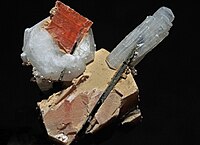
Photo from wikipedia
Abstract Oxalate-adsorbed TiO2 shows visible activity for the oxidation of ranitidine, although neither oxalate nor pure TiO2 alone absorbs visible light. The formation of an oxalate-TiO2 complex facilitates electron transfer… Click to show full abstract
Abstract Oxalate-adsorbed TiO2 shows visible activity for the oxidation of ranitidine, although neither oxalate nor pure TiO2 alone absorbs visible light. The formation of an oxalate-TiO2 complex facilitates electron transfer from oxalate to the TiO2 conduction band (CB) (i.e., a ligand-to-metal charge transfer (LMCT)) and generates superoxide/hydroperoxyl radicals (O2 −/HO2 ), which are primarily responsible for ranitidine oxidation, under visible light. The attenuated total reflection Fourier transform infrared (ATR-FTIR) spectra of oxalate-adsorbed TiO2 indicates that the formation of a LMCT complex between oxalate and TiO2 occurs through bidentate carboxylate linkages. The visible light-induced generation of photocurrent (Iph) on the TiO2/FTO electrode in the presence of oxalate confirms the LMCT mechanism in the oxalate-TiO2 complex under visible light. Kinetic studies with varying oxalate concentrations, initial pH values, and TiO2 types demonstrate that the oxidation efficiency increases as the adsorption of oxalate and the molar fraction of O2 − increase. Not only ranitidine but also other pharmaceutical pollutants, such as cimetidine, propranolol, imidazole, and nizatidine, were oxidized in the pure TiO2/oxalate/visible light system. The oxidation efficiency of the oxalate-TiO2 complex was higher than that of other organic ligand-TiO2 complexes (i.e., citrate-, EDTA-, malonate-, acetate-, and glucose-TiO2 complexes). In this regard, the pure TiO2/oxalate/visible light system can be proposed as a practical method for the treatment of pharmaceutical-contaminated water and wastewater.
Journal Title: Chemical Engineering Journal
Year Published: 2018
Link to full text (if available)
Share on Social Media: Sign Up to like & get
recommendations!